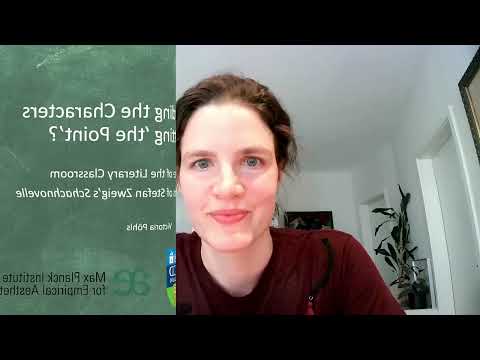 Speaker: R. L. Victoria Pöhls @victoria_poehls
Speaker: R. L. Victoria Pöhls @victoria_poehls
 Affiliation: TU Darmstadt
Affiliation: TU Darmstadt
 Co-authors: Judith Brottrager & Thomas Weitin
Co-authors: Judith Brottrager & Thomas Weitin
Title: Understanding the Characters and Getting ‘the Point’? The Influence of the Literary Classroom on Teenage Readers of Stefan Zweig’s Schachnovelle
Abstract (long version below): This study examines the impact of the literary classroom on teenagers’ perception of Zweig’s “Schachnovelle”. We investigated whether class instruction affects character perception (accuracy of trait recollection; self-perceived understanding of characters’ actions and emotions) and perceived text message (message type; confidence in message lucidity). The study exposed 56 high school students to different levels of text engagement (complete/incomplete readings, private reading or teaching focus). Data analysis indicates that the literary classroom impacted all variables except confidence in message lucidity. It suggests that a further experimentally tested teaching strategy – re-reading under a specific focus – can influence students’ perception of minor characters.

 Long abstract
Long abstract
In this study, we investigated the effects of reading a classic literary text, Stefan Zweig’s Schachnovelle, in two typical settings: a literary classroom setting compared to private readings. The aim is to discover how the experience of reading for a school context and discussing the novella in class influences young readers’ interpretation of a possible textual message and their understanding of the protagonist Dr. B. and his antagonist Czentovic.
The participants – 56 German high school students – were categorized into four groups based on their text engagement prior to the experiment (‘No Text Knowledge’, ‘Partial Reading, Private’, ‘Complete Reading, Private’, and ‘Complete in Class’) to link differences in responses to completeness of reading and the influence of the literary classroom.
Regarding the textual interpretation, we took interest in the type of overall message put forward by participants, but also in their level of certainty that the text indeed had a clear message. We hypothesized that the message types mentioned in the ‘Complete In Class’ group would be more streamlined and connected to the focus set by the teacher in class, while those mentioned by participants of the ‘Complete Private’ and ‘Partly Private’ would be more idiosyncratic. Furthermore, we assumed that, following class discussion, responses to the prompt would become more elaborate and complex, as students would have engaged in similar interpreting behavior during class, having ‘tested’ their assumptions in discussions and drawing on others’ interpretations, while this would not have been the case for all other participants.
The results indicate that the literary classroom plays a major role in students’ general preparedness to produce an interpretative message, the type of message chosen, and its formulation, but not in terms of the believed interpretability of the novella’s message. We found that, as expected, no or unspecific responses (e.g. mentioning a topic of the text, such as ‘It is about chess’, instead of a message) decreased with text engagement (No Text Knowledge: 80% of responses, Partly Private: 79%, Complete Private 58%, Complete in Class: 11%). Regarding the attributed textual messages, the streamlining hypothesis was also confirmed and this could be linked to the types of learning materials used by the teacher. Furthermore, a text analysis of the messages supported our assumption that the ‘Complete in Class’ group formulated both the most elaborate and the most complex messages, but perception of message clarity did not differ significantly between groups.
Regarding the understanding of fictional characters, we were interested whether participants could accurately attribute specific character traits to the two main characters, assuming that accuracy would increase with text engagement. Besides this investigation of text-based knowledge, the study is also designed to examine the perceived understanding of characters, or ‘Einfühlung’, i.e. the extent to which participants report that they could anticipate characters’ emotions and actions. Since fostering understanding and empathy is an explicit goal stated in the core curriculum of the German literary classroom, we expected that the perceived understanding of characters would similarly increase with text engagement.
Results connected to character perception showed a disparate pattern. While accuracy of character trait attribution was greater for the group ‘Complete in Class’ compared to the group ‘Complete in Private’ both for the protagonist (84.6% vs. 61.4% correct answers over 10 items) and the antagonist (86.1% vs. 67%), there were no significant differences between those two groups when assessing students’ self-perceived lucidity of the characters’ emotions and behaviors.
Adding complexity to what could have been a between-groups survey study, we invited students to the laboratory to engage in a practice that mirrors a commonly used teaching strategy: re-reading certain textual passages with a specific focus, e.g. on a particular character’s development throughout the novella. To that end, all 56 participants (re-)read 10 short extracts of the novella focusing either on Czentovic or Dr. B. in a supervised setting, to investigate whether such focus would alter participants’ impression of this character, improve either their accuracy in assigning the correct character traits, or their perceived understanding of the character.
Interestingly, certain kinds of re-readings produced significant differences when it came to participants’ own assessment of whether their image of the character had been altered by the focus on one of the characters: Especially if participants had been made to focus on the antagonist, their perception of that character changed or deepened (57% reported this vs. only 25% of the group who focused on the protagonist). Changes and differences between re-reading groups were smaller for the protagonist.
This indicates that the literary classroom can have a great impact on young readers’ understanding of a text and its characters, but does not greatly partake in inspiring ‘Einfühlung’ in characters. However, certain teaching methods, such as re-readings focused on minor characters who do not have the sympathy of the narrator, might be apt to inspire re-evaluation not obtained through private readings.

